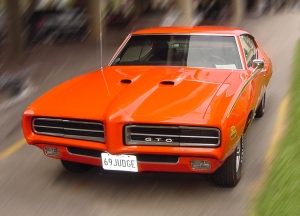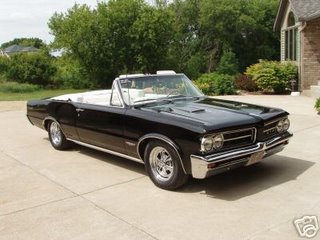The Last Pontiac GTO built
With little fanfare, the last Pontiac GTO was assembled at Holden’s Monaro factory in Australia. Earlier this year, GM’s Australian subsidiary built and auctioned its last Monaro coupe, but production of the continued in Pontiac guise until now. In February, GM announced it would end production of the GTO this year. Just weeks later, GM Vice Chairman Bob Lutz said the Pontiac GTO could return in 2008, alongside the new Chevrolet Camaro. Unlike the now-discontinued GTO, the new model is expected to feature aggressive retro-inspired styling.
Note from admin – If they create something similar to the new 2010 Camaro it may be a winner. I personally despised the car they’ve been calling the GTO from 2004 – 2007. It looked like every other family car on the road. I prefer my muscle cars look mean.
1969 Pontiac GTO

1969 Pontiac GTO "The Judge"
The 1969 model did not have the vent windows, had a slight grille and taillight revision, moved the ignition key from the dashboard to the steering column (which locked the steering wheel when the key was removed, a Federal requirement installed one year ahead of schedule), and the gauge faces changed from steel blue to black. In addition, the rear quarter-panel mounted side marker lamps changed from a red lens shaped like the Pontiac “V” crest to one shaped like the broad GTO badge. Front outboard headrests were made standard equipment on all GTOs built after January 1, 1969.
The previous economy engine and standard 350 hp 400 CID V8 remained, while the 360 hp (270 kW) 400HO was upgraded to the Ram Air III, rated at 366 hp (273 kW) at 5,100 rpm. The top option was the 370 hp (280 kW) Ram Air IV, which featured special header-like high-flow exhaust manifolds, high-flow cylinder heads, a specific high-rise aluminum intake manifold, larger Rochester QuadraJet four-barrel carburetor, high-lift/long-duration camshaft, plus various internal components capable of withstanding higher engine speeds and power output. Unlike the big-block Chevy and Hemi motors, the Ram Air IV utilized hydraulic lifters.
By this time, the gross power ratings of both Ram Air engines were highly suspect, bearing less relationship to developed power and more to an internal GM policy limiting all cars except the Corvette to no more than one advertised horsepower per 10 lb (4.5 kg) of curb weight. The higher-revving Ram Air IV’s advertised power peak was actually listed at 5,000 rpm—100 rpm lower than the less-powerful Ram Air III.
The Ram Air V was introduced in 1969. It was a special 400 block with newly designed high compression tunnel port heads and a special high rise intake manifold. A prototype GTO so equipped could go 0-60 mph in 5.2 seconds, and the quarter-mile time was 11.5 seconds at 123 mph (198 km/h). Ram Air Vs were not installed in GTOs at the factory; it was available only as an “over-the-counter” product, and most went to Pontiac racers of the time.
The significant event of 1969 was the launch of a new model called ‘The Judge’. The Judge name came from a comedy routine, “Here Comes the Judge”, used repeatedly on the Rowan & Martin’s Laugh-In TV show. Advertisements used slogans like “All rise for The Judge” and “The Judge can be bought.” As originally conceived, the Judge was to be a low-cost GTO, stripped of some gimmicks to make it competitive with the Plymouth Road Runner. During its development, however, it was decided to make it the ultimate in street performance and image. The resulting package ended up being US$337.02 more expensive than a standard GTO, and included the Ram Air III engine, Rally II wheels without trim rings, Hurst shifter (with a unique T-shaped handle), wider tires, various decals, and a rear spoiler. Pontiac claimed that the spoiler had some functional effect at higher speeds, producing a small but measurable down force, but it was of little value at legal speeds except for style. The Judge was initially offered only in “Carousel Red,” but late in the model year a variety of other colors became available.
The GTO was surpassed in sales both by the Chevrolet Chevelle SS396 and the Plymouth Road Runner, but 72,287 were sold during the 1969 model year, with 6,833 of them being The Judge. The rarest GTO was the Ram Air IV Judge convertible – only five were built.
The First Pontiac GTO – 1964
The first Pontiac GTO was an option package for the Pontiac LeMans, available with the two-door coupe, hardtop coupe, and convertible body styles. For US$ 296, it included the 389 CID V8 (rated at 325 hp (242 kW) at 4800 rpm) with a single Carter AFB four-barrel carburetor and dual exhaust, chromed valve covers and air cleaner, 7 blade clutch fan, a floor-shifted three-speed manual transmission with Hurst shifter, stiffer springs, larger diameter front sway bar, wider wheels with 7.50 x 14 redline tires, hood scoops, and GTO badges. Optional equipment included a four-speed manual transmission, two-speed automatic transmission, a more powerful “Tri-Power” carburation rated at 348 hp (260 kW), metallic drum brake linings, limited slip differential, heavy-duty cooling, ride and handling package, and the usual array of power and convenience accessories. With every available option, the GTO cost about US$ 4,500 and weighed around 3,500 pounds (1,600 kg). Most contemporary road tests used the more powerful Tri-Power engine and four-speed. Car Life clocked a GTO so equipped at 0–60 miles per hour (0–97 km/h) in 4.6 seconds, through the standing quarter mile in 14.8 seconds with a quarter mile trap speed of 99 miles per hour (158 km/h). Like most testers, they criticized the slow steering, particularly without power steering, and inadequate drum brakes, which were identical to those of the normal Tempest. Car and Driver incited controversy when it printed that a GTO that had supposedly been tuned with the “Bobcat” kit offered by Ace Wilson’s Royal Pontiac of Royal Oak, Michigan, was clocked at a quarter mile time of 12.8 seconds and a top speed of 112 mph (179 km/h) on racing slicks. Later reports strongly suggest that the Car and Driver GTOs were equipped with a 421 CID (6.9 L) engine that was optional in full-sized Pontiacs. Since the two engines were difficult to distinguish externally, the subterfuge was not immediately obvious. Sales forecast proved inaccurate: the GTO package had sold 10,000 units before the beginning of the 1964 calendar year, and total sales were 32,450.

